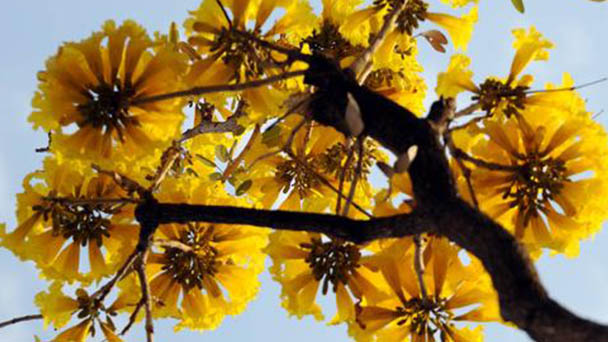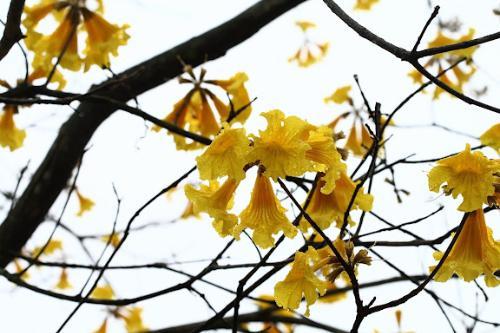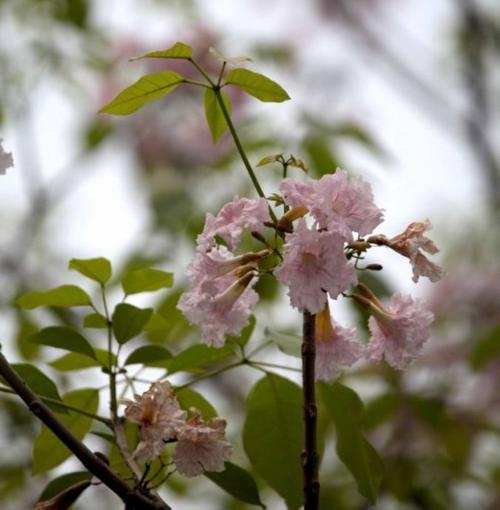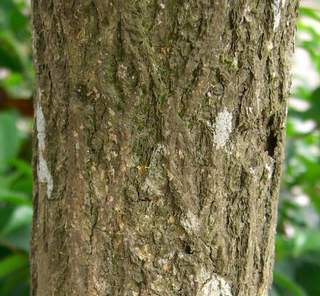Tabebuia heterophylla (pink trumpet tree) profile
Written by Maggie
Oct 30 2021

Pink Trumpet Tree (Tabebuia heterophylla) is a small to medium-sized deciduous tree that can grow up to 18 m tall. In its native land, Pink Trumpet Tree is widely grown in abandoned pastures and secondary forests. It has become a nuisance in the Pacific, particularly in dry coastal woodlands and secondary forests. Pink Trumpet Tree can grow in any soil type and can adapt to poor or degraded soils.It will form purebred monotypic colonies. This is a very fast growing species that can easily crowd out native and other rare trees. Pink Trumpet Tree branches and leaves grow almost to the base, producing a dense shade under which no other species can grow.Its thick layer of litter can also prevent native seedlings from growing.
Pink trumpet tree picture

Morphological Characteristics of pink trumpet tree
Pink Trumpet Tree is a small to medium sized tree that can grow to a height of 18m and a diameter of 60cm. The bark is wrinkled, with narrow columnar crowns and opposite palmately compound leaves. pink trumpet tree has 3-5 leaflets, elliptic to lance-acuminate or obovate, 6 -- 16cm long, leathery, apex acute or obtuse, base obtuse to rounded; Smooth surface, neat margin, petiole is 3 -- 12cm long. Large white to lavender complete flowers, a few clustered at terminals and sides, occasionally solitary. The ripe fruit of pink trumpet tree is dark brown with cigar-shaped pods, about 8 -- 20 cm long, 6.5mm in diameter, and many winged seeds, each about 2cm long.
Ecological Habits of pink trumpet tree
Pink Trumpet Tree mainly grows in afforestation, weeds, coastal areas, shrubs, grasslands, etc.It's a wind-borne species.
Pink Trumpet Tree grows extensively in abandoned pastures and secondary forests in Puerto Rico and other parts of the Caribbean. It occurs in dry or wet natural forests, except in the highest elevation of the Lukiyo Mountains and the Central Mountains. Pink trumpet tree tolerates degraded land and abandoned farm lands and often form pure-species populations in these areas. Pink trumpet tree grows well in a variety of soil types, but this plant prefers deep clays. Pink trumpet tree Occurs in sandy, calcareous, clayey, and heavy soils in Puerto Rico. The soils are acidic or alkaline. Soil sources are residues, alluvial, or accumulations. It is most common on mountain slopes and ridges, but is also found near river beds on platforms. Pink Trumpet Tree Pink Trumpet tree is particularly common in dry coastal woodlands and secondary forests in the Caribbean. Pink trumpet tree can grow in any soil type, if moisture is available, can adapt to poor or degraded soil.
Pink Trumpet Tree In Puerto Rico, it mainly blooms in the spring or dry season, and its leaves can be completely lost. Pink trumpet tree blooms sporadically at other times, and can be found on the tree for most of the year. Its seed capsules split along two lines, and the seeds scatter away from their parents over a distance of 100 m or more, depending on weather conditions. Seeds of pink trumpet tree germinate in open Spaces, forming dense new seedlings. The Institute of Tropical Forestry carried out some seed experiments in mid-1940: "There were about 70,000 air-dried seeds per kilogram, with an average moisture content of 31 per cent. After the seeds were collected, they were directly sown in the seedbed. Within two weeks, the germination rate reached 90 per cent; The seed vigor decreased to about 55 percent after a delay of 3 weeks, and no seed germinated after a delay of 5 weeks. Long time storage used seeds with 100%, 75%, 50%, 25% moisture content at room temperature and 4°C(40°F), 25 months later, with the lowest moisture content and temperature obtained the optimal germination of nearly 55%. (Find more Climbing Plants with Flowers here.)

Distribution of pink trumpet tree
Origin: South America;
Known areas of introduction: Oceania and the Pacific Ocean.
The detailed growth and invasion countries are as follows:
pink trumpet tree is native countries and regions: away, antigua and barbuda, the Bahamas, Barbados, British virgin islands, cayman islands, Cuba, the Dominican republic, the Dominican republic, grenada, guadeloupe, Jamaica, and Martinique, Montserrat, Netherlands Antilles, Puerto Rico, republic of Haiti, saint kitts and nevis, st. Lucia, saint Vincent and the grenadines, Trinidad and Tobago, the United States virgin islands, etc.
pink trumpet tree invasion of countries and regions: American Samoa, away, Bermuda, British Indian Ocean territory, the British virgin islands, cayman islands, the cook islands, Fiji, French Polynesia, Guam, Marshall islands, Mauritius, the federated states of Micronesia, Montserrat, northern mariana islands, palau, seychelles, such as the United States.
Pink trumpet tree propagation
Pink Trumpet Tree (Tabebuia heterophylla) is a wind-dispersed species.
Use of pink trumpet tree
Pink Trumpet Tree In Puerto Rico, Pink Trumpet Tree was planted on poor ridged land to repair and improve the soil. Recommended on raised slopes and ridges, pink trumpet tree is a promising forest regeneration species. It also grows well in wet, flooded land.
Pink Trumpet Tree looks and functions like an oak and ash tree.Wood is widely used in flooring, furniture, interiors, tool handles, decorative plywood, shipbuilding, oxyoke, wood products, sporting goods. The lower grades of wood are suitable for use as boxes, crates, and similar items.Its large flowers and narrow columnar crown make it one of the most popular ornamental plants planted in courtyards and roadsides throughout Puerto Rico. Pink trumpet tree will bloom within a few years after planting.
The study found that Rhody servals also appeared in areas dominated by pink trumpets, but at a much lower density.

Read Next:
Top 20 Climbing Plants with Flowers for Your Garden
Latest Updated
- Benefits of Bugleweed - 7 Science-backed Health Benefits
- Bugleweed Dangers & Side Effects - Is It Poisonous?
- How to Plant Evergreen Trees - What You Should Know
- When to Plant Evergreens - Grow Guide for Evergreen Trees
- 12 Wonderful Evergreen Shrubs for Your Garden
- 12 Popular Evergreen Plants with Pictures for Beginners
- When And How To Prune A Lilac Bush Like a Pro
- How to Grow & Care for Lilac Vine (Hardenbergia Violacea)
- Japanese Lilac Tree (Syringa Reticulata) Care & Propagation Guide
- Shumard Oak Pros and Cons - What to Know
Popular Articles
- Winter maintenance of Antirrhinum Majus
- How to Grow Terminalia Mantaly Tree
- How to Grow and Care for Crossostephium Chinense
- How to grow Antirrhinum Majus in spring
- Peristeria Elata (Dove Orchid) Profile: Info & Care Guide
- Underwatered Snake Plant (Sansevieria Trifasciata) - Signs And How To Fix
- How to Care for Brazilian Jasmine Plant (Mandevilla Sanderi)
- How to Grow & Care for Graptopetalum Purple Delight in Summer
- Rosa Chinensis (China Rose): Plant Growing & Care Tips
- How to Care for Baby Sun Rose (Aptenia Cordifolia)